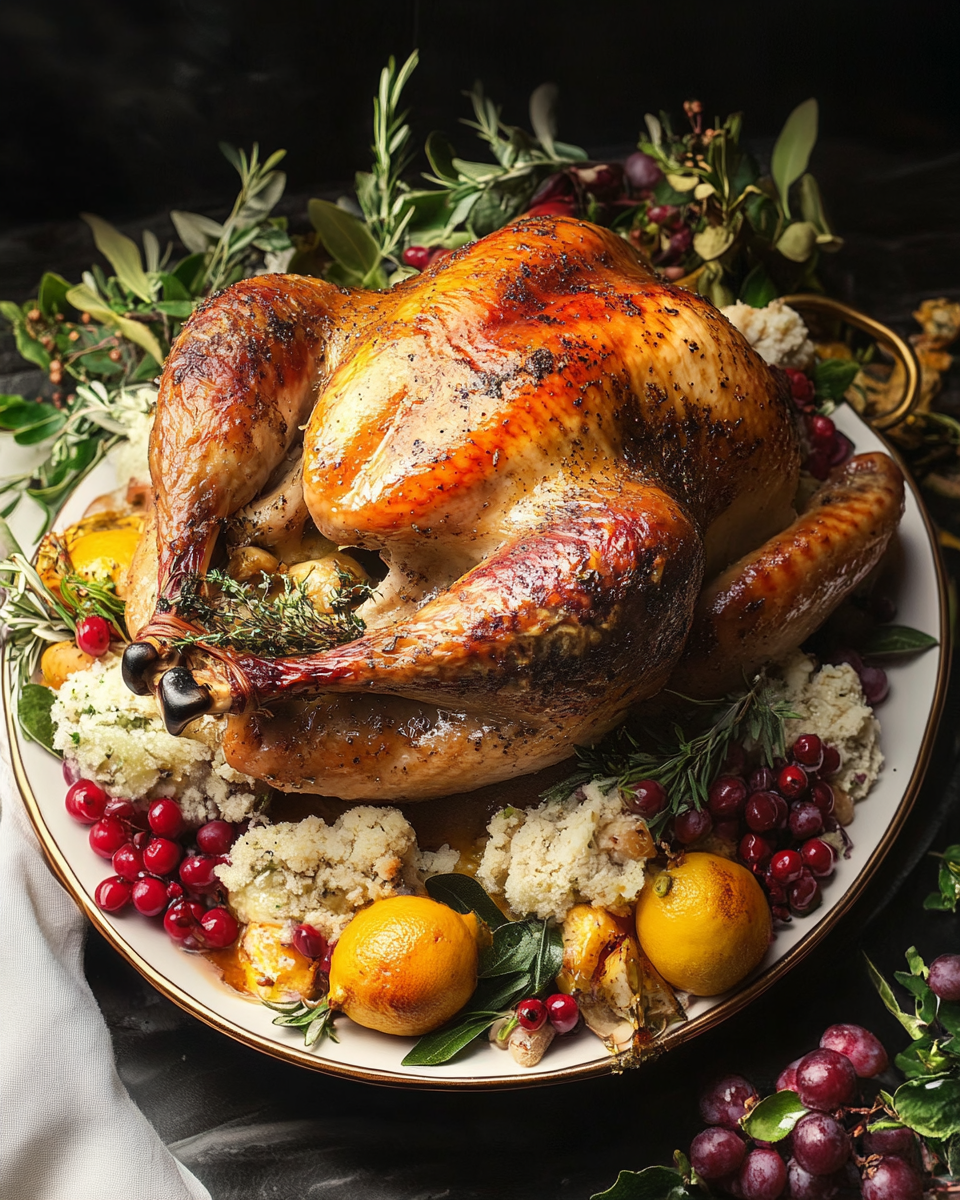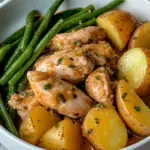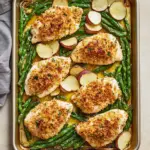The perfect herb butter roast turkey combines the golden crispness of well-seasoned skin with the tender, juicy flavors of garlic and herbs infused throughout. Its visually stunning presentation makes it the star of any festive table, from Thanksgiving to Christmas.
Ideal for family gatherings, this recipe simplifies the process of roasting a turkey without sacrificing flavor. The buttery herb rub keeps the meat moist while delivering a rich, savory aroma that will fill your kitchen with the essence of the holidays. Impress your guests with this classic centerpiece!
Full Recipe:
- 1 (14-16 pound) whole turkey
- Salt & pepper to taste
Herb Butter:
- 1 cup (2 sticks) unsalted butter, softened
- 1 tablespoon fresh sage, chopped finely
- 1 tablespoon fresh thyme, chopped finely
- 1 tablespoon fresh rosemary, chopped finely
- 4 cloves garlic, minced
- 1 teaspoon salt
- 1/2 teaspoon pepper (or to taste)
Inside the Turkey:
- 1 lemon, halved
- A few sprigs of fresh sage, thyme, and rosemary
- 1 head of garlic, broken into cloves and peeled
Directions:
- Prepare the turkey: Take the turkey out of the fridge an hour before roasting to bring it to room temperature. Set it on a baking sheet to catch any spills. Remove the giblets and neck if included. Pat the turkey dry with paper towels.
- Make the herb butter: In a bowl, combine softened butter, minced garlic, and chopped herbs with salt and pepper. Mash with a fork until evenly mixed.
- Preheat the oven: Set the oven to 450°F and adjust the racks for ample space for the turkey.
- Season the turkey: Rub the turkey generously with the herb butter, covering the skin evenly. Fill the cavity with lemon halves, herb sprigs, and garlic cloves. Tuck the wings under the bird and tie the legs together with kitchen twine for a neat appearance.
- Roast the turkey: Place the turkey breast-side up on a rack in a roasting pan. Insert the pan into the oven and immediately lower the heat to 350°F. Roast for about 13 minutes per pound (approximately 3 hours for a 14-pound turkey).
- Check doneness: Use an instant-read thermometer to ensure the thickest part of the thigh reads at least 165°F. If the skin browns too quickly, tent the turkey loosely with foil.
- Rest the turkey: After removing from the oven, let the turkey rest for 20 minutes to allow the juices to redistribute.
- Carve and serve: Carefully carve the turkey and serve with your favorite sides and gravy made from the pan drippings.
Prep Time: 20 minutes | Cooking Time: 3 hours | Total Time: 3 hours 20 minutes
Kcal: 520 kcal | Servings: 8-10
The Art of Crafting the Perfect Herb Butter Roast Turkey
The herb butter roast turkey is a quintessential holiday dish, embodying the heart and soul of festive feasting. Whether it’s Thanksgiving, Christmas, or any special occasion, this recipe promises a moist, flavorful turkey with golden, crispy skin that captures the spirit of celebration. It’s more than just a meal; it’s a culinary centerpiece that symbolizes warmth, togetherness, and tradition.
The Importance of Preparation
Roasting a turkey can feel like a daunting task, especially for those new to holiday hosting. However, with thoughtful preparation, this process can be seamless and enjoyable. Selecting the right-sized bird is key—plan for about 1 to 2 pounds per guest to ensure everyone is satisfied, with plenty of leftovers. A properly thawed turkey is essential for even cooking; remember to allow one day of thawing in the fridge for every five pounds of turkey.
Another crucial consideration is seasoning. A good herb butter mixture is the foundation of flavor in this recipe. The blend of softened butter, garlic, and fresh herbs like rosemary, sage, and thyme ensures that every bite of turkey bursts with aromatic richness. Applying this mixture both inside the cavity and over the skin not only enhances taste but also helps achieve that coveted crispy skin.
The Science Behind Crispy Skin
One of the standout features of this roast turkey is its perfectly browned and crispy skin. This is achieved through a few key techniques. First, patting the turkey dry before applying the herb butter removes excess moisture, which can hinder browning. Second, roasting the bird at a high temperature initially creates a caramelized crust, while reducing the temperature allows the turkey to cook evenly without burning.
For optimal results, it’s important to avoid basting. While many traditional recipes call for regular basting, this can actually make the skin soggy and disrupt the cooking process. Instead, the herb butter creates a self-basting effect, locking in moisture while allowing the skin to crisp beautifully.
The Role of Resting
Resting the turkey after roasting is an often overlooked yet essential step. This allows the juices to redistribute throughout the meat, ensuring a moist and tender texture. Cutting into the turkey too soon can cause the juices to spill out, leaving the meat dry. Letting the turkey rest for at least 20 minutes also gives you time to prepare other elements of the meal, such as gravy or sides, without feeling rushed.
Serving Suggestions and Complementary Sides
A roast turkey of this caliber deserves equally impressive sides. Classic options like buttery mashed potatoes, savory stuffing, and green bean casserole are traditional staples that pair beautifully with the herbaceous flavors of the turkey. For a modern twist, consider serving roasted root vegetables, cranberry-orange relish, or a vibrant kale and pomegranate salad to add color and freshness to the meal.
Don’t forget the gravy! The drippings from this turkey are a goldmine of flavor, making them the perfect base for a rich, velvety gravy. Deglazing the roasting pan with a splash of white wine or chicken stock and whisking in a roux will yield a sauce that ties the entire meal together.
Tips for Success
Achieving a flawless roast turkey requires a combination of technique and attention to detail. Here are some additional tips to ensure success:
- Use a meat thermometer: This is the most reliable way to determine when your turkey is fully cooked. The thickest part of the thigh should register at least 165°F.
- Avoid over-stuffing the cavity: While it may be tempting to pack the cavity with stuffing, doing so can prolong cooking time and lead to uneven results. Instead, use aromatic ingredients like lemon, garlic, and fresh herbs.
- Elevate the turkey: Placing the turkey on a roasting rack ensures even heat circulation, preventing the bottom from becoming soggy.
- Foil tenting: If the skin begins to brown too quickly, loosely cover the turkey with foil to prevent burning while allowing it to cook through.
Why This Recipe Stands Out
This herb butter roast turkey is a testament to simplicity and flavor. By focusing on quality ingredients and straightforward techniques, it eliminates the need for complicated steps like brining or constant basting. The result is a turkey that is not only visually stunning but also incredibly delicious. Its versatility makes it suitable for both novice cooks and seasoned hosts looking for a fail-proof recipe to impress their guests.
The Joy of Leftovers
One of the greatest perks of roasting a turkey is the abundance of leftovers. This recipe leaves you with flavorful meat that can be transformed into a variety of dishes. From comforting turkey pot pies to hearty soups and sandwiches, the possibilities are endless. Leftovers also freeze well, allowing you to enjoy the taste of the holidays long after the celebrations have ended.
Conclusion: A Dish Worth Celebrating
The herb butter roast turkey is more than just a meal; it’s a tradition that brings families and friends together. Its inviting aroma and stunning presentation create an atmosphere of celebration, while its rich, savory flavors satisfy even the most discerning palates. Whether you’re hosting your first holiday dinner or continuing a long-standing tradition, this recipe is sure to be a crowd-pleaser. By following these tips and embracing the joy of cooking, you’ll create a turkey that not only looks and tastes incredible but also becomes a cherished memory for years to come.






